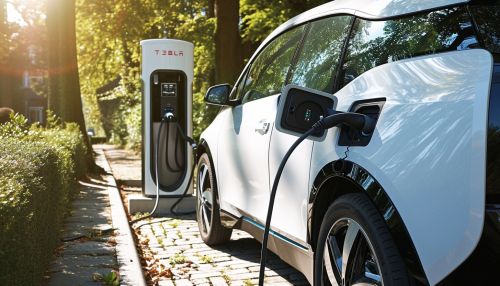Electric Vehicle Charging Station
Introduction
An Electric Vehicle Charging Station, also known as an electric recharging point, charging point, EVSE (Electric Vehicle Supply Equipment), and by various other names, is an element in an infrastructure that supplies electric energy for the recharging of Electric Vehicles, such as plug-in electric vehicles, including electric cars, neighborhood electric vehicles and plug-in hybrids.
History
The charging station is the latest in the long history of fuel dispensers that began with the hand pump, and has evolved into the most technologically advanced and complex infrastructure that we see today. The first rudimentary charging stations were developed during the 19th century with the advent of electrical energy. However, it was not until the late 20th and early 21st centuries that charging stations became a common part of urban infrastructure due to the rise in popularity of electric vehicles.
Types of Charging Stations
There are three main types of EV charging - rapid, fast, and slow. These represent the power outputs, and therefore charging speeds, available to charge an EV. Note that power is measured in kilowatts (kW).
Slow Charging
Slow charging units are rated at up to 3 kW and are best suited for 6-8 hours overnight charging. A typical slow charging unit will charge a compatible EV with a 40kWh battery in 6-12 hours.
Fast Charging
Fast chargers are rated at either 7 kW or 22 kW (single or three-phase 32A). Charging times vary on unit speed and the vehicle, but a 7 kW charger will recharge a compatible EV with a 40kWh battery in 4-6 hours, and a 22 kW charger in 1-2 hours.
Rapid Charging
Rapid units are the quickest way to charge an EV, often found at locations close to main routes in the country. Most units provide DC charging, but there are some AC rapid chargers too. Rapid DC chargers are at least 50 kW, whereas rapid AC chargers are 43 kW. Both will charge the majority of EVs to 80% in around 30-60 minutes.
Charging Connectors
There are three main types of electric vehicle charging connectors; Type 1 (J1772), Type 2 (Mennekes), and the Tesla Type 2.
Type 1 (J1772)
The Type 1 plug is a single-phase plug which allows for charging power levels of up to 7.4 kW (230 V, 32 A). The standard is used in the Chevrolet Volt and Nissan Leaf, among others.
Type 2 (Mennekes)
The Type 2 plug is a three-phase plug and can carry more power. It is used by many manufacturers, and is the European standard plug.
Tesla Type 2
The Tesla Type 2 connector is a slightly modified version of the Type 2 Mennekes connector, with a different internal pin wiring. It is used on the Tesla Supercharger network.
Charging Network
The charging network is a network of charging stations that are interconnected through a common source of power and communication. This allows for the efficient distribution of power to the charging stations and allows for the management of the charging stations through a central system.
Charging Station Infrastructure
The charging station infrastructure includes the physical charging station, the power supply infrastructure, and the communication infrastructure. The physical charging station includes the charging point and the equipment used to control and manage the charging process. The power supply infrastructure includes the power source and the distribution network. The communication infrastructure includes the communication network and the software used to manage the charging process and the charging stations.
Charging Station Technology
Charging station technology includes the hardware and software used to manage the charging process, the communication between the charging station and the electric vehicle, and the communication between the charging station and the central management system.
Charging Station Management
Charging station management includes the management of the charging process, the management of the charging stations, and the management of the charging network. This includes the scheduling of charging sessions, the monitoring of the charging process, and the maintenance of the charging stations.
Charging Station Business Models
There are several business models for the operation and financing of charging stations, including the utility-owned model, the third-party owned model, and the hybrid model.
Environmental Impact
The environmental impact of charging stations is largely determined by the source of the electricity used to charge the electric vehicles. If the electricity is generated from renewable sources, the environmental impact is significantly reduced.
Future Developments
Future developments in charging station technology include the development of wireless charging stations, the integration of charging stations with renewable energy sources, and the development of smart charging stations that can interact with the electric grid to optimize energy use and reduce costs.
See Also
- Electric Vehicle
- Electric Vehicle Supply Equipment
- Electric Vehicle Network
- Electric Vehicle Charging Connector


